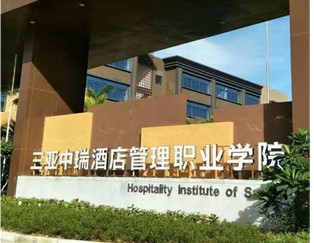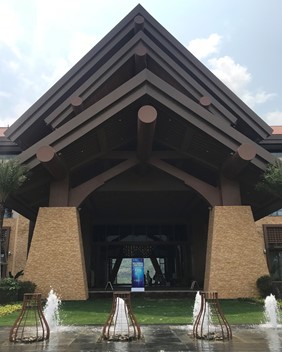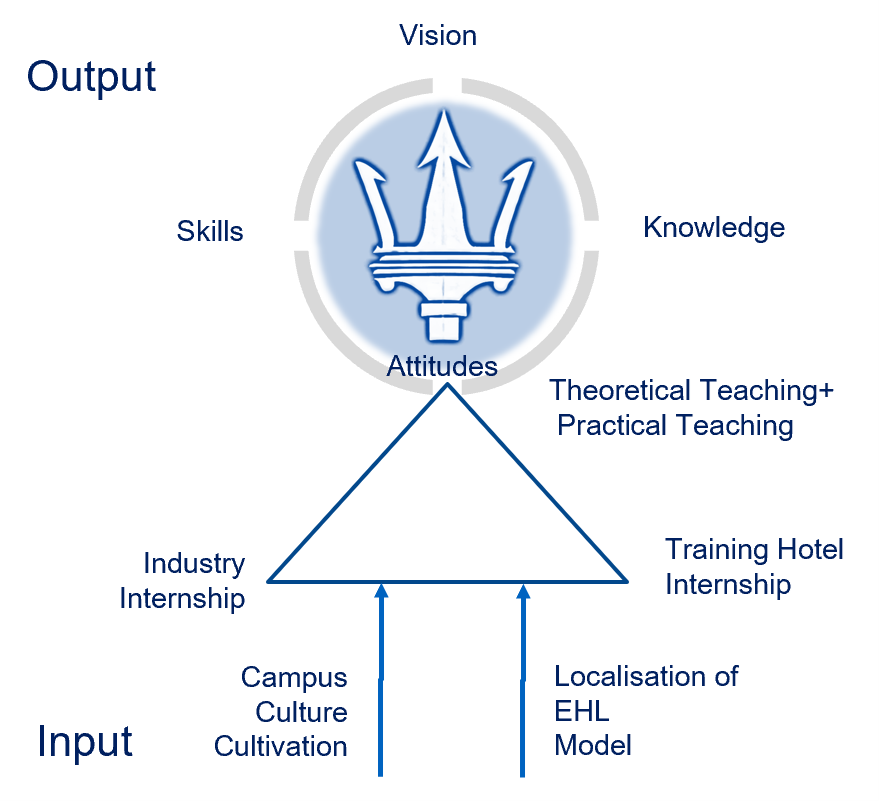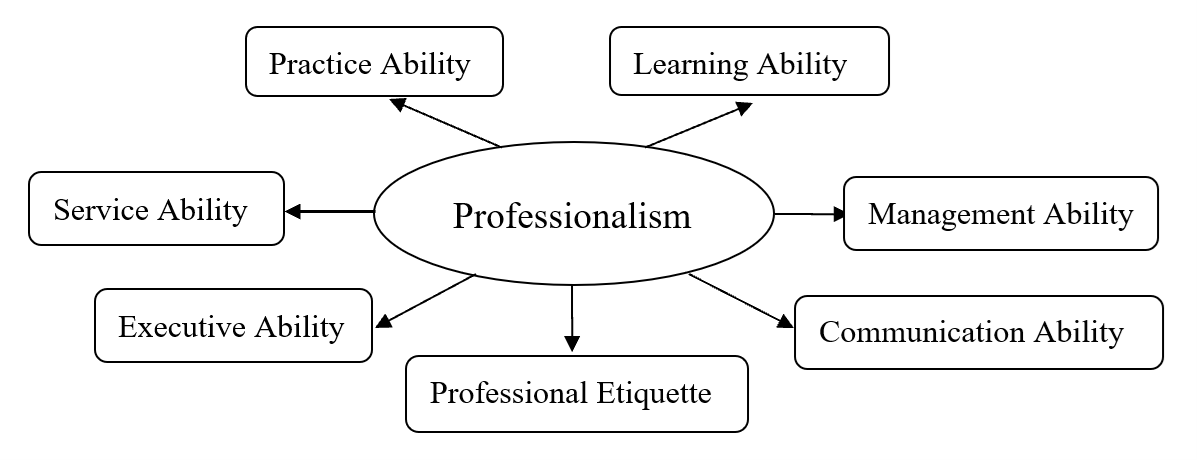Chapter 9: A Hierarchical Model for Talent Cultivation in Hospitality Programmes: The case of the Hospitality Institute of Sanya
Shichun Yu; Liyang Dong; Chun Liu; and Jingjing Yang
Shichun Yu, Beijing Hospitality Institute
Liyang Dong, Atlantis Sanya
Chun Liu, Beijing International Studies University
Jingjing Yang, Macao Institute for Tourism Studies
Abstract
Whilst practical education components of hospitality programmes in China garnered considerable attention, their implementation modes and outcomes remain unclear. This chapter explores these issues through a case study of the Hospitality Institute of Sanya. Firstly, this study reviews the tripartite education model adopted by the institute, consisting of three sections: Input, Learning by doing, and Output. In the Input section, campus culture cultivation and the Ecole Hôtelière de Lausanne (EHL) model certification are addressed. The section on learning by doing includes classroom activities, teaching hotel traineeships and formal hotel internships. Finally, the output section involves assessment of students in terms of their skills, knowledge, vision and attitudes. The system has proven to be successful, as evidenced by industry managers’ comments. Moreover, students can improve their abilities to serve, practice, learn, execute, communicate and manage on the basis of professional etiquette. The model links theory with practice, and adjusts the original Western EHL model to the Chinese context, considering the features of Chinese students and the Chinese education system.
Introduction
The fast-changing needs of the labour market create new challenges for education providers. On the one hand, service organisations complain about difficulties in recruiting qualified staff. On the other hand, fresh graduates complain about difficulties in finding jobs. This discrepancy might partially lie in the mismatch between service organisations’ demands and graduates’ skills. Lam and Xiao (2000) believe that the number of hotel and tourism management (HTM) graduates produced by universities falls short of the industry’s demands mainly due to a lack of qualified teachers and effective talent cultivation programmes. This situation has become a bottleneck restricting the development of national or regional tourism in China (Wu, Morrison, Yang, Zhou, & Cong, 2014). To address this gap, in addition to academic expertise, rich internship experience has increasingly become a key factor in obtaining jobs. Therefore, undergraduate hospitality programmes should cultivate talents among students to meet the industry’s demands for qualified staff. Historically, a series of educational and training initiatives was developed, including the technical and further education sector, advanced general national vocational qualifications, dual-system vocational education and training and national/Scottish vocational qualifications to bridge the academic/industry divide (Abbott-Chapman, 2006; Baethge & Wolter, 2015; Clayton, Fisher, & Hughes, 2005; Williams & Raggatt, 1998). However, several scholars argue that many colleges pay too much attention to practical skills whilst neglecting professional and management abilities (Zhan, Zhan, Xie, & Zhong, 2020).
In response, academic scholars and hotel practitioners have developed the ‘School + Hotel’ model. For example, aside from collaborating with hotels around the world, Ecole Hôtelière de Lausanne (EHL) established a restaurant (i.e., Le Berceau Des Sens) and simulated the hotel environment. Similarly, the former School of Hotel Management of Cornell University and the School of Hotel and Tourism Management (SHTM) of The Hong Kong Polytechnic University own and operate hotels open to the public. These practices gained much acclaim owing to their advantages in cultivating students’ theoretical expertise and developing practical knowledge.
With the rapid development of the hospitality sector and calls for qualified staff, the practical education components of hospitality programmes in China have garnered considerable attention. Based on the successful experiences of EHL, SHTM and Cornell University, Chinese scholars suggested several models for hotel management programmes in China. For instance, Ding (2016) proposes a personnel training framework for management ability cultivation-oriented hotel management after comparing EHL and Cornell University. Penfold et al. (2012) use the Guilin Institute of Tourism in China to clarify the curriculum review, redesign and implementation process of a new hotel management programme based on students’ and faculty’s perceived importance of and satisfaction with different attributes relating to teaching quality and the overall programme. Whilst the aforementioned research provides useful information for understanding hospitality management programmes in China, the implementation modes and outcomes of the practical education components of hospitality programmes in the country remain unclear.
The chapter examines the approach of the Hospitality Institute of Sanya (HIS) to investigate how it cultivates students’ knowledge, hones strong skills, creates a broad international vision and develops professional attitudes based on an input–response–output tripartite system. Firstly, this study reviews the HIS then discusses the three dimensions of its programmes before assessing the opinions of industry leaders regarding its success. The objectives of this study are to explore the talent cultivation mode of the HIS and examine the outcomes of the mode from the perspective of employers.
Hospitality Institute of Sanya (HIS)
Figure 1 Hospitality Institute of Sanya

The Hospitality Institute of Sanya (Figure 1), covering a land area of 144,000 square meters, is located in Haitang Bay in Sanya, Hainan Province, China. It is adjacent to the Haitang Bay Duty-free International Shopping Complex and is surrounded by international luxury hotels. The HIS is managed by the Beijing Hospitality Institute and the first hospitality-oriented educational institute in Sanya. It was founded in 2017 and attained EHL academic accreditation in October 2018. Moreover, it is the only vocational college in China that passed this academic certification, becoming the 10th EHL certified academic institution in the world (HIS, 2017). As of 2020, the HIS has 1,780 students.
The HIS has a training front desk, Western cuisine restaurant, Chinese cuisine restaurant, cafe, wine tasting training room and three demonstration kitchens (a bakery, Chinese cuisine kitchen and Western cuisine kitchen). In addition, it operates a teaching hotel, La Fountain Hotel & Resort Sanya, in collaboration with its owner. The property covers a building area of 59,700 square meters, with 284 hotel rooms and 210 apartments.
Tripartite Approach to Education and Training
HIS adopts a tripartite approach to education (Figure 2). The objectives of the programme are to create a clear learning culture and provide a combination of theoretical and practical teachings and internship opportunities for regular posts in its teaching hotel. Ultimately, the programme aims to equip students with skill, knowledge, vision and attitude (SKVA) portraits to realise the balance between being a person and attaining quality skills, certain knowledge, a broad international vision and positive attitudes. Its three dimensions include Input, Learning by Doing and Output. The three dimensions are briefly discussed below.
Figure 2 HIS Tripartite Education Model
Part 1 – Input Section
The HIS strives to implement proper campus culture cultivation to help students develop effective learning routines and habits. For example, students must strictly follow dress code and etiquette standards. In addition, teachers and students are required to wear formal business attire during regular classes. Moreover, etiquette standards, including elevator etiquette, classroom etiquette, workplace etiquette and telephone and email etiquette are established.
A monitoring team called the ‘dandelion team’ consists of 146 people, including 116 student volunteers and 30 faculty and staff volunteers. The monitoring team is responsible mainly for the inspection, supervision and training of teacher and student behaviours and etiquette. Teacher and student violations of the norms of conduct and etiquette are recorded in the campus culture management system. A ‘student court’ is held before a decision on punishment is made on violations of rules of conduct and etiquette and other transgressions.
In addition, the HIS signed a consultation agreement with EHL at the beginning of its establishment in 2015. The EHL was involved in the campus planning and design as well as in the curriculum and student development design. EHL consultants visit the HIS once a year for auditing and support. For practical application, the HIS revised and adjusted the EHL model to fit Chinese students. The adjustment can be divided mainly into three parts. Firstly, in view of students’ unfamiliarity with the major and industry, the HIS added a week-long entrance course for freshmen to provide them with basic knowledge on the industry and discipline. Secondly, to enhance the outcome of practical teaching, preliminary practical courses (e.g., catering services, room service and so on) and practical theory courses (e.g., conceptual and theoretical knowledge before practical operations) are added to 8 to 12 class hours per week in one practical module. Meanwhile, internships in the teaching hotel are arranged to increase students’ experience in customer service. A teaching hotel is not included in the EHL education system. Thirdly, internship mobilisation and commendation meetings are held before and after the industry internship to ensure the internship effect. Tutors are assigned to 15 interns, whose responsibilities include instructing students in the internship programme and facilitating the relationship between the hotel and students.
Part 2 – Learning by Doing Section
The education and training system has three dimensions. The first dimension is the completion of students of theoretical and practical courses. Approximately 60% of HIS teachers and staff are from the hospitality industry. The credit ratio of theoretical courses to practical courses is approximately 1:1. Subjects include theoretical and practical components designed to provide a broad yet practical tertiary-level education. In addition, practical courses on baking and Western and Chinese cuisines are taught and demonstrated in the demonstration kitchen. Students cook various foods under the guidance of the practical teacher in the kitchen then sell them to teachers and students in the canteen.
The second dimension is an internship in the teaching hotel La Fountain Hotel & Resort Sanya, which serves the functions of operations and teaching support (Figure 3). Students are required to complete 228 hours of practical exercises at the hotel, including catering production, catering services and room service. Under the guidance and arrangement of teachers and hotel department heads, students are assigned to relevant positions in the hotel to work with full-time employees. Teachers serve as deputy managers to assist department managers in carrying out the work and observe, record, correct and summarise the performance of the students. Given that Chinese students have nearly no work experience in the hotel industry before enrolment, this link between laboratory practice and hotel industry internship can effectively solve the shortcomings of students’ work experience.
Figure 3 La Fountain Hotel & Resort Sanya

Finally, in the third dimension, students complete off campus internships in five-star hotels. This programme is unique, because whilst most internships are arranged at the end of students’ studies, the HIS follows the ‘sandwich’ principle and organises internships for the third and sixth semesters. Thus, students have two opportunities to be exposed to industry practice. The first internship is called the cognitive internship and mainly for frontline hotel positions, and the second internship is called the management internship. The internship assignment clearly states that students must complete management-related tasks and the graduation design during the internships.
Part 3 – Output Section – SKVA Portraits
The goal of the first two sections is to produce students with SKVA portraits, an acronym standing for quality Skills, certain Knowledge, a broad international Vision and positive Attitudes. Students obtain theoretical knowledge in the classroom and improve their practical abilities in hands-on courses and internships. Moreover, students broaden their vision by participating in various international events and activities as volunteers, including the ‘Boao Forum’ and ‘Miss World’. In the above process, students’ attitudes towards life and other aspects are strengthened. The HIS aims to train students to have excellent SKVA.
Effectiveness of the Programme
The effectiveness of the programme can be best assessed to by employers who hire HIS students. Interviews were conducted with the human resource directors or general managers of hotels where 287 HTM sophomore students completed their internship. The hotels are all five-star or luxury hotels in Sanya. The interviews were conducted in Chinese to ensure the effectiveness of the interview. Each interview was recorded with the interviewee’s permission. The interviews were transcribed verbatim from a recording then translated to English by professionals. The scripts were further encoded openly, axially and selectively for categorising and analysing. The data reached saturation at the ninth interviewee. A total of nine hotels hired the HIS students for their first internship from July 2018 to February 2019.
The interview questions covered the following themes:
- Understanding of the HIS
- Evaluation of the HIS interns at respective hotels
- Evaluation of the interns’ work attitudes, knowledge, skills and vision
- Performance of volunteers at events
- Comparison between the HIS interns and those of other institutions
The rules of grounded theory were used to analyse the data. Firstly, concepts from the meaningful units of the original information were extracted and labelled using open coding. The principle of labelling is to be as open as possible and rely on the instincts of the researcher (Xie, 2018).
Axial coding was used to determine the possible logical relations between each category, categorise the meaningful units and establish connections. This study integrated 68 concepts formed by open coding and classified 11 conceptual categories (Table 1).
Table 1. Industry’s perception of HIS graduates
| Frequencies | Conceptualisation | Categories |
| 30 | Jump into work quickly; learn quickly; master standards quickly; have satisfactory learning and hands-on abilities; are stable; skilful, especially, in table laying and making beds; and have satisfactory competency | Ability to study and practice |
| 16 | Have grooming; are stately, confident, skilled, natural, professional and expert; demonstrate satisfactory appearance, qualifications and behaviours | Professional image |
| 14 | Demonstrate quick response and satisfactory attitudes, are earnest, have initiative, are active and proactive | Working attitudes |
| 12 | Learn the demands of guests, serve in advance, demonstrate service awareness, provide satisfactory service, can observe and predict guests’ needs, exhibit a strong desire to serve, have proactive consciousness | Ability to predict needs and service awareness and ability |
| 11 | Have qualifications, demonstrate stability and ease, are natural, comfortable, calm, vigorous and responsible | Vocational qualifications |
| 9 | Are confident, make eye contact, express appropriate greetings, are polite, impressive and kind hearted | Politeness |
| 9 | Ask pertinent questions, are anxious about their future career and willing to learn, have a thirst for knowledge, education, ideas and vision | Knowledge and professional levels |
| 5 | Take orders, have executive abilities, are obedient | Executive abilities |
| 5 | Are noble, bear hardships, are persistent, can deal with difficult work | Endurance of hardships |
| 4 | Have ability to communicate and express themselves, are calm and relaxed | Communication abilities |
| 4 | Well organised, hardworking and self-managed | Organisation and management abilities |
Selective coding, namely, core coding, represents the third tier of grounded theory. It aims to select a core genus from discovered concept generated through systematic analysis, which is effective and can include most research results in a relatively broad theoretical scope akin to ‘a rope of a fishing net’ (Chen, 2000, p. 334). Using open coding and axial coding as well as the discussion on the previously discovered conceptual categories, this study combined concepts with similar genera and extracted seven main categories for the HIS students’ professionalism. Figure 4 presents a summary of the outcome.
Figure 4 Students’ professionalism model in the talent cultivation framework
Discussion and Conclusion
The employers were very impressed with the quality of the HIS interns. The interviewees perceived the interns to have satisfactory professional skills and the ability to learn standard operation procedures quickly. They stated that most of the interns were confident, professional and polite. According to one interviewee:
Your 18 classmates are really the best interns we’ve ever had. The general manager of our hotel said at the farewell party, ‘It’s not a compliment’.
Our hotel has accepted seven interns from the HIS, and the departments’ feedback is very good. The department heads said that they had good working attitudes, working skills and learning abilities. What impressed me most was an intern in the front office department who was very active. I hope she chooses our hotel when she graduates.
The interns were perceived to be quick learners who showed proactive initiatives. In other words, they demonstrated positive customer care attitudes, strong vocational qualities and professional knowledge and potential to occupy management positions.
Compared with other schools, they are faster and better at learning new things and new skills, more stable, more polite … are more confident and act more naturally at work.
They are enthusiastic, serious, responsible and proactive. A student named Chen received 125 praises from customers on the website in half a year and got our rewards every month. Miss E
This study summarised and constructed the tripartite talent cultivation model of the HIS, which consists of three sections, namely, input, learning by doing and output. In the input section, campus culture cultivation and the EHL model certification are addressed. The section on learning by doing includes teaching, practicing and internships, which entail teaching hotel traineeship and industry internship. The output section assesses students’ excellence in terms of their SKVA portraits. On the basis of talent cultivation SKVA portraits, a professionalism model for the HIS students was presented, which is a collection of their learning, practical, service, executive, management and communication abilities based on their professional etiquette and image. The model links theory with practice and adjusts the original Western EHL model to the Chinese context to consider the features of Chinese students and the Chinese education system. This summary on the tripartite model and exploratory research on students’ professionalism can help HTM improve talent cultivation quality and alleviate the shortage of talents in the industry.
References
Abbott-Chapman, J. (2006). Moving from technical and further education to university: An Australian study of mature students. Journal of Vocational Education and Training, 58(1), 1–17. https://doi.org/10.1080/13636820500507666
Baethge, M. & Wolter, A. (2015). The German skill formation model in transition: From dual system of VET to higher education? Journal for Labour Market Research, 48(2), 97–112. https://doi.org/10.1007/s12651-015-0181-x
Chen, X. (2000). Qualitative research methods and social science research. Educational Science Press.
Clayton, B., Fisher, T., & Hughes, E. (2005). Sustaining the skill base of technical and further education institutes: TAFE managers’ perspectives. National Centre for Vocational Education Research. Retrieved from http://search.ebscohost.com/login.aspx?direct=true&db=eric&AN=ED495185&site=ehost-live
Ding, X. (2016). Comparative analysis and implications of North American and European hotel management undergraduate education ——Taking hotel management school in Lausanne and School of Hotel Management in Cornell University as examples. Journal of Sichuan Tourism University, (5), 85–88.
Ecole Hôtelière de Lausanne. (2020). Admissions Requirements for the Bachelor. Retrieved from https://www.ehl.edu/en/admission-fees/admissions-requirements/bachelor-admissions
Fan, M. & Chen, X. (2009). A Survey on the Major Choice of Chinese Undergraduates. University Education Science, 3, 91–96.
Helsby, G., Knight, P., & Saunders, M. (1998). Preparing students for the new work order: The case of advanced general national vocational qualifications. British Educational Research Journal, 24(1), 63–78. https://doi.org/10.1080/0141192980240105
Hospitality Institute of Sanya. (2017). Overview of Hospitality Institute of Sanya. http://www.his.edu.cn/about/news/1.html. Accessed on 13 June, 2020.
Lam, T. & Xiao, H. (2000). Challenges and constraints of hospitality and tourism education in China. International Journal of Contemporary Hospitality Management, 12(5), 291–295. doi:10.1108/09596110010339643
Penfold, P., Wei, L., & Ladkin, A. (2012). Developing hospitality education in China: A case study of Guilin institute of tourism. Journal of China Tourism Research, 8(1), 61–77.
Veal, A. J. (2006). Research methods for leisure and tourism: A practical guide (3rd ed.). Essex: Pearson.
Williams, S. & Raggatt, P. (1998). Contextualising public policy in vocational education and training: The origins of competence-based vocational qualifications policy in the UK. Journal of Education and Work, 11(3), 275–292. https://doi.org/10.1080/1363908980110304
Wu, M. (2013). “I would love to work in tourism, but … “: Exploring the outcomes of an ethnic tourism education initiative. Journal of Hospitality, Leisure, Sport & Tourism Education, 12(1), 47–58.
Wu, M., Morrison, A. M., Yang, J. K., Zhou, J. L., & Cong, L. L. (2014). Cracks in the ivory tower? A survey-based analysis of undergraduate tourism education and educators in China. Journal of Hospitality, Leisure, Sport & Tourism Education, 14(1), 26–38. doi:10.1016/j.jhlste.2013.12.002
Xie, Y. (2018). Tourism research methods. Beijing: China Travel &Tourism Press.
Zhan, L., Zhan, J., Xie, X., & Zhong, R. (2020). Optimization Path of Practical Teaching Five-Way System for Hotel Management Specialty – Based on the “Five-Way Integration” Model. Journal of Sichuan Higher Institute of Cuisine, 5, 98–100.



